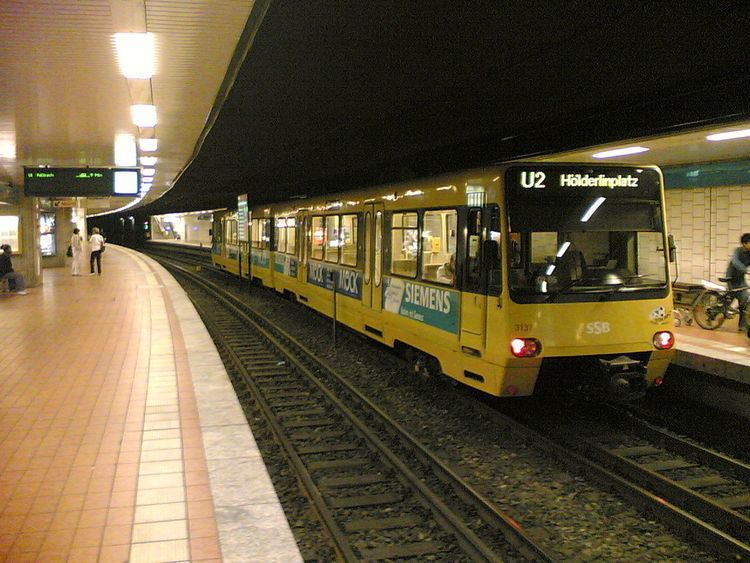Annual ridership 174.9 million (2014) | Number of stations 203 (2013) | |
 | ||
Number of lines 15 (& 2 special event lines) Website | ||
The Stuttgart Stadtbahn is a light rail system in Stuttgart, Germany. The Stadtbahn began service on 28 September 1985. It is operated by the Stuttgarter Straßenbahnen AG (SSB), which also operates the bus systems in that city. The Stuttgart Stadtbahn is successor system of a tram network (Straßenbahnen) that characterized the urban traffic in Stuttgart for decades.
Contents
- Lines
- History
- Current light rail system
- Light rail vehicles
- Color
- Hours of operation
- Fares and ticketing
- U12 Northern Extension
- U12 Connection to the Europaviertel
- U14 Rebuilding the station Wilhelma
- U6 Airport link
- Possible projects
- References
The network of Stuttgart Stadtbahn covers much of Stuttgart and also reaches the neighbouring towns of Remseck am Neckar, Fellbach, Ostfildern, Leinfelden-Echterdingen and Gerlingen (clockwise). Currently, the Stuttgart Stadtbahn system is made up of fifteen lines (U1-U9, U12-U15, U21 and U24) and two special event lines (U11 and U19), serving 203 stations, and operating on 130 kilometres (81 mi) of route. In 2014, the Stuttgart Stadtbahn carried 174.9 million passengers.
Lines
As of 2016, the Stuttgart Stadtbahn system is made up of thirteen main lines (U1-U9 and U12-U15), two special lines (during the construction site between Charlottenplatz and Staatsgalerie; U21 and U24) and two special event lines (U11 & U19):
History
Stuttgart Stadtbahn, now all standard gauge (1,435 mm (4 ft 8 1⁄2 in)), developed out of a traditional tramway system, which in Stuttgart was metre gauge.
In 1961 the city council of Stuttgart decided that a general modernization of the municipal tram system was needed; in central areas, the tram should be relocated underground, and in peripheral areas it should get new tracks that would be separate from road traffic. Concurrent proposals for a new completely underground subway (U-Bahn) were rejected in 1976. At the same time it was decided to enhance modernization of the existing tram in combination with a change from metre gauge to standard gauge. For this reason, Stuttgart made the intermediate effort of rebuilding almost all its tracks with mixed-gauge, on which old streetcars (SSB GT4, built 1959–1965) could run as well as new metro cars (SSB DT 8, in regular service since 1985).
Current light rail system
The Stadtbahn system runs over 257 kilometres (160 mi) of rail track, and 231 kilometres (144 mi) of rail line, covering 130 kilometres (81 mi) of route. (The Stuttgart rail system also encompasses a rack railway (Line 10), a funicular (Line 20), and a weekend heritage streetcar line (Line 21).) In the city centre as well as in other densely built-up districts of the city, the Stadtbahn runs underground. The Stadtbahn uses the "U" logo like the underground systems (U-Bahnen) in other German cities. However, here the "U" does not stand for untergrund (underground) but for unabhängig (independent, meaning independent of other traffic infrastructure). Outside the densely built up areas, the Stadtbahn runs on the surface, often along roads with level crossings, though on a separate right-of-way. However, in the Stammheim district, the U15 line's trains operate with street running and share space with other traffic.
Light rail vehicles
The system is operated with 179 light rail vehicles, operates on standard gauge track, and is electrified at 750 volts DC. On December, 8th, 2007 the ongoing replacement of the city's tram lines was finally completed after 27 years.
Color
Since the coat of arms of Stuttgart shows a black, rampant horse on a yellow or golden field, the Stuttgart Stadtbahn (as well as all the buses and the last old trams) comes in yellow with black or dark blue window frames.
Hours of operation
The Stuttgart Stadtbahn operates from 04:00 - 01:00.
Most routes are served by two or more lines in the city centre, so there is a train every few minutes at most stations.
Fares and ticketing
The Stadtbahn is part of the regional transport cooperative, the Transit and Tariff Association Stuttgart (VVS), which coordinates tickets and fares among all transport operators in the metropolitan area. Besides the Stadtbahn, these include the SSB's bus networks, together with the Stuttgart S-Bahn, operated by a subsidiary of Deutsche Bahn AG (DBAG), and DBAG's RegionalBahn regional train services within the VVS area.
